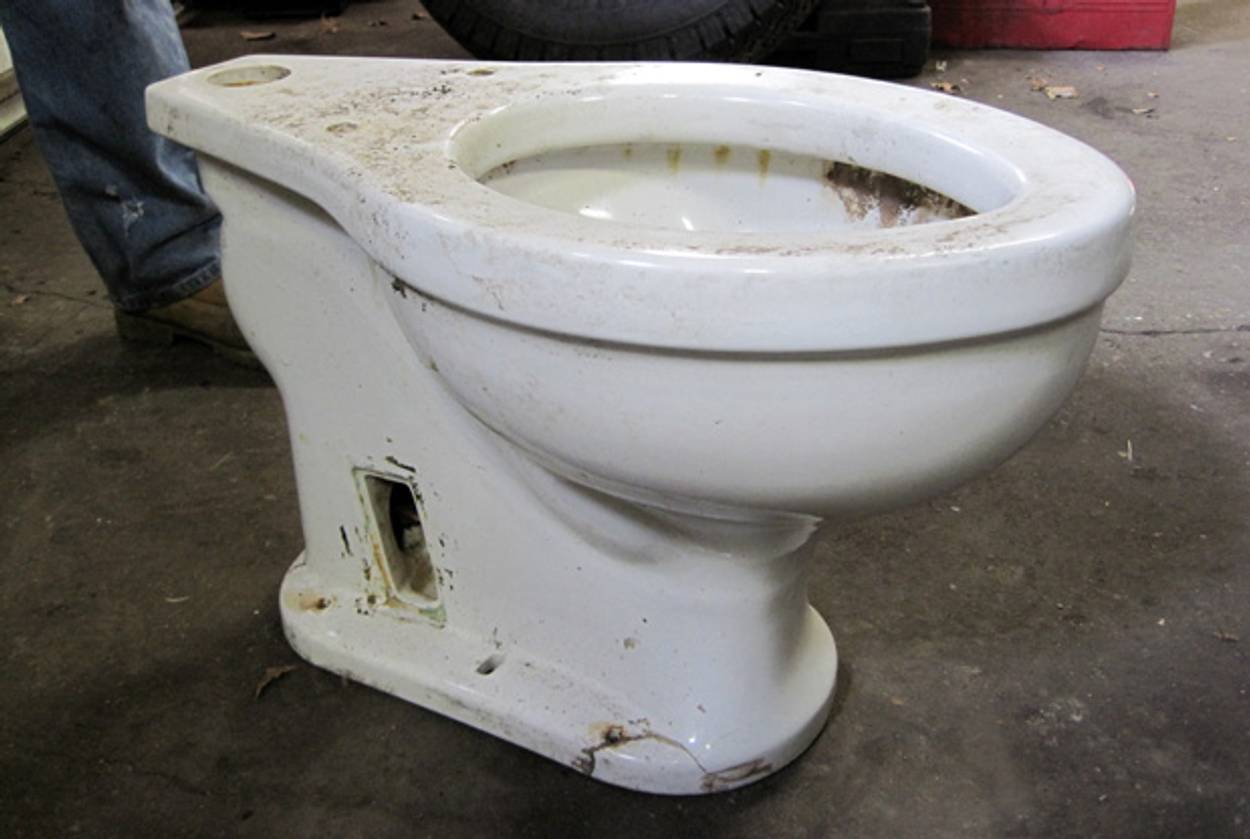Hitler’s Toilet Is in New Jersey: A Yacht’s Commode, in an Auto-Repair Shop
For half a century, Greg’s Auto Repair has housed the commode from Aviso Grille, the Führer’s biggest yacht




Florence, N.J., isn’t too different from other small towns in the Garden State, one marked, if anything, by a slew of very ordinary sights—chain flower shops at every major intersection, decidedly lower gas prices, and a few cozy diners. But it is also home to something else, acquired by Greg Kohfeldt when he bought Sam Carlani’s auto-repair shop here almost 20 years ago: Adolf Hitler’s toilet.
According to Kohfeldt, the toilet came off of Hitler’s biggest private yacht, the Aviso Grille, which was between 400 and 500 feet long, and at the time one of the biggest private boats in existence. “He wanted to ride it down the Thames in London and go live in Windsor Palace when he invaded,” Kohfeldt told me on a subzero morning last week as he pulled a sink—also from the ship, and now in pieces—out of a box and laid them out for me to examine each of the maker’s stamps and faucets. Another resident of Florence, Dick Glass—an expert on Hitler’s yacht—told me that the ship was armed, had a crew of 245 men, a private room for Eva Braun, and was bigger than J.P. Morgan’s ship Corsair. The Aviso Grille also played a significant role in one particular moment in history: Hitler’s Grand Admiral Karl Dönitz stood on the deck of the ship on May 1, 1945, and gave the first word of the Führer’s death and took command of Germany.
After the war ended, the Aviso Grille was taken to the United States and ended up in the hands of New Jersey shipyard owner Harry Doan, who illegally charged visitors 25 cents to board and tour Hitler’s Yacht. However, according to Glass, both Doan and the federal government wanted to prevent the ship from becoming a memorial to Hitler, and so it was scrapped in Doan’s salvage yard in the early 1950s.
At that point, Sam Carlani needed a new toilet. Doan, his close friend and poker buddy, told him he had one available.
Kohfeldt pointed out to me that the toilet has all the traits of a toilet from a ship—including an open side slot for seawater to be pumped in. The knobs on the faucet bear text written in Blackletter—the famous and classically German family of typefaces that Hitler adored. (The Nazis, in 1933, chased typographer Jan Tschichold out of Germany for advocating use of sans-serif fonts instead of Blackletter, among other design travesties.) The toilet has been a “functional tourist attraction” since 1952, Kohfeldt said. People would take road trips—as I had—just to see it. (Indeed, the toilet is listed in Roadside America’s online guide.)
But last year, the toilet finally did make it to London as Hitler intended, when a British game show—Four Rooms, a lot like a British version of Antiques Roadshow—flew Kohfeldt and the toilet out to appear on the air to be sold. Although they couldn’t find a buyer, Kohfeldt said he was happy to accept the free trip and relished an opportunity to mock the Führer by taking the toilet to places Adolf only dreamed of.
While Kohfeldt seems proud of his object’s notoriety, he seems remarkably unexcited by the fact that he owns Hitler’s toilet. This may be because the story of Hitler’s possessions in Florence only begins with his toilet.
When the ship came to the United States, it was taken apart, and many of the pieces were distributed throughout Florence. One man took the teak wood from the paneling on the yacht and built himself a porch. The American Legion Post 194 in Florence still has one of the tables from Hitler’s ship in their office. The aforementioned Dick Glass used a port window for his own house; he also collected the brass screws from the Grille with his father to build their own yacht. Other bits and pieces of the Grille—the relics of Hitler’s great aspiration of taking over the United Kingdom—are scattered throughout nearby towns.
It’s hard to be jaded or unimpressed by items of historical significance, especially ones that aren’t in museums, or ones that were very personal. And yet if anybody is capable of this, it is the residents of Florence. Perhaps this is because the fragments of Hitler’s Grille have been seen for so long not as historical artifacts, but instead as functional objects used in daily routines. Or perhaps it is because it is easy to see Hitler’s uniform or decorative knives in a museum because we see him strictly as a historical being, but the moment we see his bathrobe or silverware—let alone wear it and eat with it—we stop believing that it belonged to Hitler. While we know he existed, it is still difficult to see such a broad historical figure as someone who lived outside of his speeches and parades. In fact, Kohfeldt’s toilet is a thing worth flying to London or a sight worth driving across the country to see precisely because even when standing before it we are unable to concretize in our minds the image of Hitler sitting on it. If we do that, we have to imagine which of his psychotic fantasies he was thinking about, or what the temperature of the cabin was, or even stranger, what it must have been like to sit there as Hitler. And so even when presented with the fact—the hard, white, glassy truth that is Hitler’s toilet—it is nearly impossible to accept the reality of what the object is simply because the notion of Hitler doing normal things feels apocryphal. Almost as apocryphal as the story of his toilet sitting for the last half-century in New Jersey garage.
Alexander Aciman is a writer living in New York. His work has appeared in, among other publications, The New York Times, Vox, The Wall Street Journal, and The New Republic.